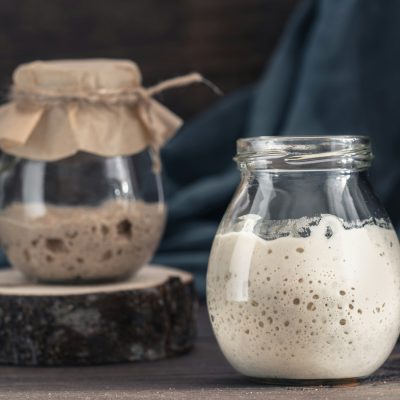
What is Sourdough Starter?

Just 2 Ingredients, the rest comes naturally!
Sourdough starter is flour and water, left out to ferment for a few days, and fed regularly! This is as old as time itself, in fact, in biblical times, using fermented leavening was commonplace. But, fermenting flour to use in making bread is much older! One of the oldest discoveries of active sourdough is back in Switzerland dating back to 3500 BCE! Egyptians used natural yeast and bacteria to make bread and beer even earlier than that!

Don’t Panic! Making fresh sourdough bread from scratch can be a bit overwhelming, but, many people have great results on their first try! And the results are well worth the effort, trust me. Starter is made from only flour and water, and left to ferment, which is super-healthy and beneficial, but also alive! You need to get care and feeding instructions, so be sure to sign up for our newsletter for tips, tricks, recipes, and you’ll get a head start on your lifelong Sourdough journey!
Let's MAKE STARTER!

Ideally, our starter should be a few weeks to months old for best results, but you can make bread in about 5-6 days with a brand new batch of starter. You can start your own starter with 2 simple ingredients, but it will take about a week before it’s usable, so be prepared to get a routine, and stick to it!
If you follow the formula, 1/2 of your active starter should either be USED, or DISCARDED each day! And a more mature starter, gives better results and more flavor.
If you’re ready to get STARTED making bread right away, you can buy our Master Starter kit (coming soon).
What You'll Need:
Medium Mason Jar, or Similar
FILTERED, OR SPRING WATER (warm water starts better, about 90deg. F.)
Do not use fresh tap water, it probably has chlorine, and my impede the development. Let it sit on the counter for a few hours first
Unbleached, un-enriched, white all purpose or bread flour
That’s it! Combine in your mason jar with a 1:1: ratio of water to flour, total
NEVER use enriched, or bleached flour! These contain manmade chemicals and proteins, preservatives, and other “additives” that many people have grown sensitive to.
We like “King Arthur” brand flour.


Feeding Instructions:
Never FEED after midnight, or you’ll get a grumpy starter! (Not really, just kidding.)
Use a rubber band around your jar to show how much your starter is growing! It should almost double in volume before you use it.

Feeding is simple, daily, you need to DISCARD 50% of your starter that is in the jar, and replace the discard with 1: to 1: of fresh flour and water.
If you store your starter in a warmer place, it will double faster, but not too warm! Starter over 95 degrees may start to kill of the good bacteria, and cause your starter to be sluggish.
Don’t worry if you have more starter than you can use, save it, and feed it! It should be ready to make more bread in a few hours, under ideal circumstances. Also, don’t be afraid to share your discard with a friend, they’ll love you for it!
(Just be sure to give them proper care and feeding instructions, so they don’t end up with any gremlins!)
Discard
You should save some of your discard, and put it in the fridge with an airtight container. This stuff is great for other recipes, and to revive your starter mix should it go bad (almost never happens!) If you’re not making bread every day, store your starter in the fridge after use, and before it’s next feeding. When you’re ready to make bread again, take it out, and feed it with warm water, and wait for it to double once again!

Final thoughts about starters

You can store starter in your pantry in it’s dried out form for years. Yes, years.
What to do with your dehydrated starter kit
Get it hydrated!
Dried starter needs 2 things, water and more flour. The inactive yeast and bacteria cultures are just waiting for food! You should add equal parts water and dried starter to a large mason jar, and wait for the magic!

Once it starts to re-liquify, add more flour and water (also known as “feeding“) to get your active starter activated!
(Note: this could take a couple of days, depending on your environment)
Once you notice it rising after each feeding, you’re ready to bake bread!
Starter should not be intimidating, you can easily revive any starter that looks flat or watery by giving it a good feeding and watching it rise. Buy Dried starter in our STORE!.






